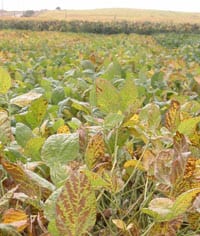 Brown stem rot may be the culprit of yield losses in the western Corn Belt. Recognizing brown stem rot isn’t easy as symptoms are not evident until late in the growing season. Often, brown stem rot symptoms are mistaken for either early crop maturity or a result of dry soils.
Brown stem rot may be the culprit of yield losses in the western Corn Belt. Recognizing brown stem rot isn’t easy as symptoms are not evident until late in the growing season. Often, brown stem rot symptoms are mistaken for either early crop maturity or a result of dry soils.
Brown stem rot is caused by the fungus Phialophora gregata, which survives on crop residue left on the soil surface. Eventually, the pathogen invades the vascular system of the soybean plant, where it impedes water and nutrient movement, causing internal browning of the stem (see photo).
 Brown stem rot can also be mistaken for sudden death syndrome or stem canker due to the similar leaf symptoms of the three diseases. To identify BSR, examine plants at full pod stage by cutting stems longitudinally in several places. Check for a chocolate-brown discoloration in the pith, especially at and between nodes near the soil line. Initially, the discoloration may only be visible at the nodes, but as the plant ages and cool temperatures prevail, the discoloration will become continuous through the stem.
Brown stem rot can also be mistaken for sudden death syndrome or stem canker due to the similar leaf symptoms of the three diseases. To identify BSR, examine plants at full pod stage by cutting stems longitudinally in several places. Check for a chocolate-brown discoloration in the pith, especially at and between nodes near the soil line. Initially, the discoloration may only be visible at the nodes, but as the plant ages and cool temperatures prevail, the discoloration will become continuous through the stem.
Wilting, premature defoliation and lodging may occur and are more likely when infected plants are subjected to drought stress.
Cool temperatures, especially in early August, followed by hot, dry weather during the late pod-fill, will have a greater negative effect on yield. Other factors that favor BSR include short rotations, susceptible varieties, overwintered stem tissue and the presence of SCN.
Effective management of BSR is possible with crop rotation, selection of resistant varieties and residue management. Contact your AgVenture Yield Specialist to discuss a specific plan for your field and to find soybean varieties with BSR resistance.
Sources: Soybean Research & Information Initiative
Photos: University of Wisconsin.